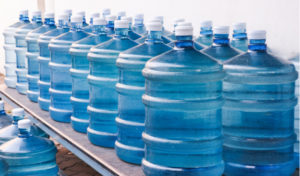
Image used under license from Shutterstock.com
Your final goal in storing water is: To have water when you need it most. To do that, you need to determine what containers work best for your situation.
Once you have your container(s), you want to make sure they are rinsed and disinfected before filling them up. Most come ready to go out of the box, but you want to make sure.
You can watch how to disinfect containers on YouTube. I like rinsing with plain old Clorox and letting them sit for about a half hour. Then let them stand overnight before filling with water using an RV potable water hose.
Next, you want to treat the water for long-term storage. Clorox works well here too, as does grapefruit seed extract, and other solutions available at Amazon.
With Clorox, for example, you can Google how much to put in depending on the size of the container you’re using. For smaller containers, I like: You Must be 21 to Drink—two drops per one liter.
Imagine the “1” being the letter “L” to remember the one in “21” is the liter not the number of drops. Tricks are always good to have in your back-pocket when you’re in the thick of things.
I was talking with friends last week in Houston and asked them what they do for water storage. They have a 55-gallon barrel in their garage and treat it with grapefruit seed extract. They have a self-priming pump, which you can shop for online, which creates a syphon for easy access.
A syphon is one of the reasons I like storing in a garage or shed because of the ease in being able to cycle the water every five-years or so down your driveway or into your yard.
A syphon is impossible when storing in the basement because the barrel needs to be higher than the hose to create the flow. You’ll need an electric pump or lots of trips up and down the stairs with buckets (more on this in my next post tomorrow).
If you live in an area where temps dip below freezing and you’re storing water in the garage make sure to leave room for expansion from frozen water. You can wrap or insulate your barrels too.
Remember, for today, whatever you do decide to do is better than what you hope to get around to doing—hope is not a strategy.
You have all the tools you need to get your water storage needs in motion today. And along the way, you will find strategies that will work best for you. My guidelines will help you have water when you need it most and to find the peace of mind you deserve, today.
Read more about Preparing Yourself for the Next Disaster here.
E.J. Smith - Your Survival Guy
Latest posts by E.J. Smith - Your Survival Guy (see all)
- Your Survival Guy Breaks Down Boxes, Do You? - April 25, 2024
- Oracle’s Vision for the Future—Larry Ellison Keynote - April 25, 2024
- Investing Is Math - April 25, 2024
- Breaking: New Rules on Trillions in IRAs and 401(k)s - April 24, 2024
- When You’re in Control, You Have Opportunities - April 24, 2024















